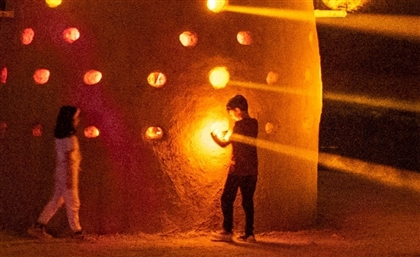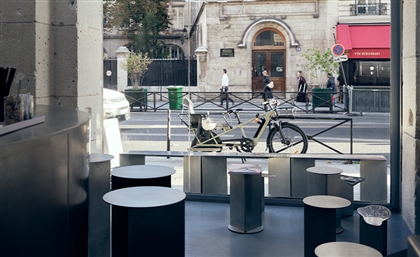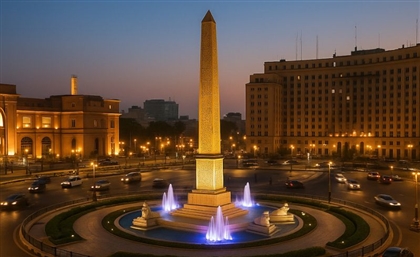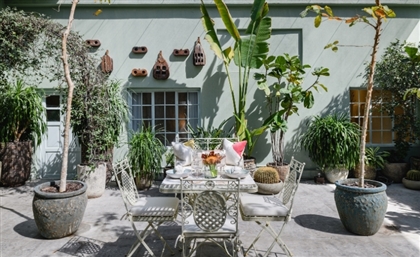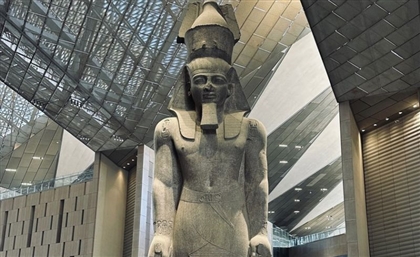Omar Chakil Reimagines Egyptian Alabaster in Paris Design Debut
Egyptian designer Omar Chakil unveils ‘Transcendence’ at PAD Paris 2025 with Galerie Gastou, merging heritage with contemporary design.
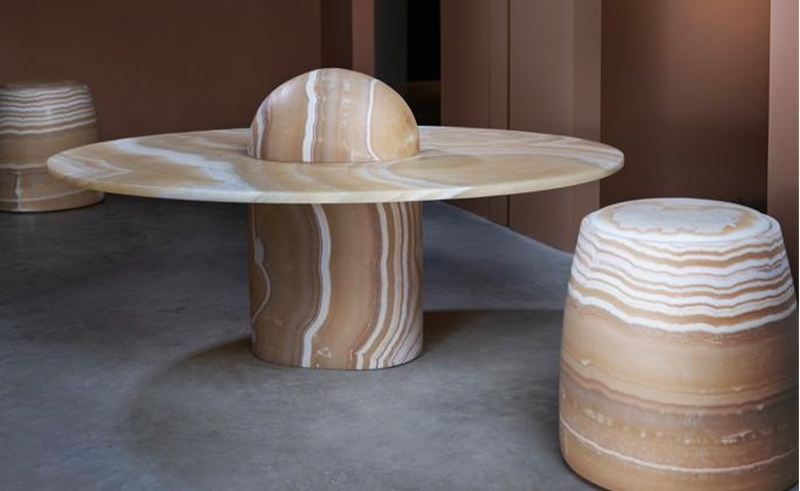
In his debut at PAD Paris 2025 with the acclaimed Galerie Gastou, designer Omar Chakil presents ‘Transcendence’—a sculptural series that reinterprets Egyptian alabaster through a contemporary lens. Born to an Egyptian father and a Lebanese mother, and raised in France, Chakil draws from a diverse cultural palette to craft works that blur the line between art and design.
Sourcing raw alabaster from Egypt and pairing it with refined Italian marbles, Chakil’s pieces transform ancient materials into modern artefacts. The collection is characterised by organic lines and flowing silhouettes, creating a tension between the sacred and the sculptural.
In this SceneHome interview, Chakil shares the personal journey behind his work—the unexpected challenges, the stories hidden within alabaster, and the moment hesitation gave way to revelation. He speaks of symbols that are both familiar and untamed, of carving not just objects but emotion into stone. Each piece carries more than form; it holds a dialogue between art and design, shaped by instinct, struggle, and discovery.
Your work reimagines symbols that have endured for millennia, balancing between preservation and reinvention. How does this dialogue unfold in your practice, particularly in your new collection at PAD Paris with Galerie Gastou, which explores the theme of ‘Transcendence’?
To transcend is to rise beyond, to challenge conventions of time and function, to craft something that doesn’t just sit within the realm of design but also ignites thought and emotion. I respect pure functionality, but I’m more intrigued by the spaces where form becomes something more—where it shifts perception.
I don’t seek to reinvent—I seek to listen. Every material holds a story, and alabaster, with its luminous depths, whispers of centuries past. But history isn’t a weight; it’s a doorway. I step through it, not to preserve, but to translate, to ask: What emotions can this stone stir today? For me, originality isn’t about being different—it’s about transcending to discovery. When creation is rooted in deep, personal inquiry, it resonates. The past is always present, but its echoes are not constraints.
Egyptian alabaster is central to your work. What was it like rediscovering and reintroducing this material into contemporary design?
When I returned to Cairo in 2017 after a life in Paris, I sought to work with local materials. Alabaster wasn’t my first choice, until a friend urged me to reconsider. Once revered but nearly forgotten, its luminous, almost futuristic quality intrigued me.
In 2018, my first alabaster collection transformed exploration into revelation. More than beautiful, the stone became a bridge between past and future, Egyptian heritage and French sensibility. Drawn to what’s overlooked, I found in alabaster a way to reinterpret tradition, letting its ethereal glow craft a dialogue between history and modernity.
Your work has long explored abstraction and esoteric connections within alabaster, yet this collection leans more explicitly into Ancient Egyptian symbolism—Sobek, Uraeus, and scarabs—through a contemporary lens. What drew you to these particular symbols, and how do they translate into modernity?
It all started with Victor Gastou, who suggested incorporating quintessential Egyptian symbols—the scarab and the crocodile—into the work. At first, I hesitated. These motifs are so deeply ingrained in Egypt’s visual culture that they risk feeling overly familiar. But that’s also their power. A universally recognised symbol carries an inherent transcendence—it allows for reinvention, for reinterpretation that resonates on a deeper level.
My work has always drawn from ancient Egypt—its materials, its mysticism—but I favoured abstraction over direct representation. I was more interested in alabaster’s esoteric qualities, the way light moves through it, and its timelessness. Yet, the more I engaged with these motifs, the more I saw their potential. They weren’t just symbols; they were vessels of transformation, protection, and power, deeply relevant today.
The crocodile was our starting point. Sobek embodied strength, protection, and fertility, yet there was something menacing about him. In ancient Egypt, the Nile crocodile commanded both fear and reverence—so much so that entire cemeteries of mummified crocodiles exist. The challenge was balancing its raw power with a sense of softness. Stone, after all, is rigid, but I often seek to carve fluidity into it, to tease out a certain sensuality.
I scanned the tail of a Nile crocodile, translating its raw texture into a marble bench that feels almost fossilized. Instead of alabaster, I chose Italian marble, as if the crocodile itself had migrated through time. Shattered quartz crystals, the essence of alabaster, were embedded in resin, mimicking scales along the surface. The form echoes a time capsule—an object that holds both memory and transformation. And there’s a playfulness to it too: sitting atop a crocodile’s tail, its power reimagined as something functional yet still laced with a quiet, lingering tension.
Then came the scarab, a symbol of rebirth and renewal. The Resurrection table, crafted from alabaster, onyx, and marble sourced from Egypt, Italy and Iran, brings together materials from three civilizations that have profoundly shaped human history. Round and deceptively simple, it carries layers of meaning.
Finally, the Uraeus, the cobra—a symbol of protection, ever-watchful atop pharaonic crowns. Years ago, I designed a birth chair, and I wanted to revisit themes of fertility and power through the lens of the serpent. Unlike in other cultures, the cobra wasn’t feared in ancient Egypt; it was revered. I sought to merge these narratives—creation, guardianship, and strength—into something tangible.
What challenges did you face in resurrecting Egyptian alabaster and shaping it for modern design?
The challenges with alabaster are many, starting with access. Despite Egypt’s vast quarries, the stone remains surprisingly difficult to source—overshadowed by imported marbles from Italy, France and China. When available, it’s often cut into thin slabs, unsuitable for the sculptural forms I create.
Then there’s the stone itself—alive with unpredictability. Alabaster, like travertine, hides fractures and voids beneath its surface. You never truly know its secrets until you carve into it. Clients often fall in love with a particular veining pattern, hoping to replicate it, but that’s impossible. Each block carries a unique geological history, shaped by ancient floods and shifting climates—its story written in stone. My approach has always been to let the stone speak, highlighting its natural beauty rather than overpowering it.
Your work challenges the notion that objects exist purely for function. Do you see design as something beyond utility—perhaps as a medium for storytelling?
Absolutely. In fact, I see storytelling as a function in itself. Emotion, narrative and meaning—these are just as integral to design as form and utility. The distinction between art and design is often debated. Many designers, especially in France, resist being called artists, arguing that design is a discipline rooted in skill, precision and problem-solving—much like architecture. Art, by contrast, is often seen as a more intuitive, hands-on practice. But I don’t believe everything needs to be categorised so rigidly. Why should these worlds remain separate?
For me, transcendence is key—creating objects that defy expectations of function. When design carries a story, it moves beyond the material, becoming something deeper, something felt.
Your work often engages with the idea of permanence—sculpting a legacy from stone. Do you see your pieces as future artifacts, much like the Egyptian relics that inspired them?
I hope so. That’s the whole point. This is why I resist the term collection. It carries connotations of seasonal trends, of something fleeting, even disposable. I don’t see my work that way. If this is a new collection, does that mean the previous one is obsolete? I prefer to think of my pieces as a continuous body of work, evolving over time rather than being confined to cycles of production.
These objects, whether a sculpted lamp or a one-ton marble dining table, aren’t meant to be replaced in a year. They are designed to endure, to be lived with, and to accumulate meaning over time. What truly frustrates me is the modern impulse to discard—to be bored with something simply because it isn’t new. That mindset doesn’t resonate with me. I want to create objects that resist that kind of ephemerality, that hold their presence across generations.
Your pieces live in spaces but also tell stories. How do you imagine people interacting with them? Should they be used or revered—or something in between?
They should absolutely be used. That’s the whole point. When I exhibited my work previously, I placed signs on the pieces that read Please Touch. I wanted to create the exact opposite of the typical museum experience, where objects are untouchable. My work is meant to be felt—its textures, its weight, the way light moves through it.
So yes, interaction is key, but there’s also a certain respect that should come with it. These pieces are meant to be lived with, not just looked at.
How did your connection to Galerie Gastou come about, and what does this collaboration mean to you?
Galerie Gastou was a world I once admired from afar—a threshold between art and function that felt almost mythical. As a child in Paris, I’d pass by, mesmerised, unsure if what I saw were lamps, sculptures, or something entirely new. Back then, as a musician, I’d joke that one day, I’d create pieces worthy of that space. It felt impossible—until it wasn’t.
Years later, when Victor Gastou discovered my alabaster work, that distant vision began to take shape. Our collaboration unfolded organically, built on shared reverence for material and form. ‘Transcendence’ is the culmination of that journey—an exploration of limits, of pushing past the known, of manifesting something once only imagined.
Photography Credit: B.Dos
- Previous Article This Alexandrian Cafe in Kafr Abdo is Straight Out of a Sketchbook
- Next Article Six Unexpected Natural Wonders to Explore in Egypt








